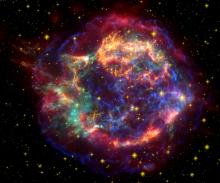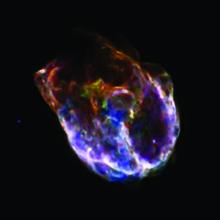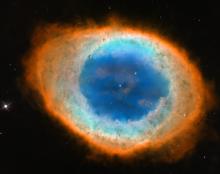Listen to today's episode of StarDate on the web the same day it airs in high-quality streaming audio without any extra ads or announcements. Choose a $8 one-month pass, or listen every day for a year for just $30.
You are here
Making Elements II
The Sun is a big nuclear reactor. Temperatures in its core reach tens of millions of degrees — hot enough for hydrogen atoms to “fuse” together to make helium. In fact, the Sun converts more than 650 million tons of hydrogen to helium every second. A small fraction of the hydrogen is converted to energy, which makes the Sun shine.
That same process powers most of the stars in the universe. And it’s the first step toward creating all the chemical elements on the periodic table.
For the least-massive stars, the process actually stops there. Their cores can’t get hot enough to make anything but helium. For stars that are roughly half the mass of the Sun or heavier, though, the process continues.
When a star that’s as massive as the Sun converts the hydrogen in its core to helium, the core shrinks, which makes it much hotter. When it gets hot enough, the next cycle of nuclear reactions begins. This round makes mainly carbon, nitrogen, and oxygen. Stars that are a bit heavier than the Sun make more of these elements, along with a smattering of a few others.
When the star dies, most of the heavier elements are trapped in its dead core. But a few of them are expelled into space along with the star’s outer layers, which are still made of hydrogen. These elements may then be incorporated into new stars, planets, and perhaps living organisms — creation born in the hearts of stars.
We’ll talk about what happens in the heaviest stars tomorrow.
Script by Damond Benningfield





